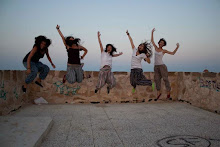Mediterranean architecture is like poetry. It tries to say everything without really saying it. One takeaway that I remember from our class's visit to the University of Alicante is that a hallmark of a Mediterranean building is finding ways to bridge the outside and inside while still clearly defining a building. For example, at the University of Alicante, the architecture department connects several parts of a single building using covered walkways. Although the walkways are open to the outside air and to the elements, they still very much contain a feeling of being "within" the building, due to its structure and design.
Similarly, the Caixa Forum in Madrid is an example of defining a plaza without setting up a clear perimeter. Instead it defines the plaza's edges through the ceiling, with the overhanging building defining what is "in" the plaza or not.
The urban spaces in Spain are meant for ritual, both the mundane and the spectacular. Plazas are built for the daily walks around the block that residents routinely take. But they're also built for the grand, wild bonfires that happen once every year. During the midday siesta, they're empty, burning hot concrete spaces that teens loiter on. The urban spaces really come alive during these majestic ceremonies, but they breathe when they host their everyday, normal ceremonies.
This being our last day in the class, I have to say that I'll miss everyone dearly. I'm so thankful for this summer for teaching me to think a different way and for forever changing the way I look at cities in the future. Thank you to Alejandro, Heidi, Bernie, and Iris for being fantastic instructors, to my classmates for being great people to learn with and from, and to the lovely staff at the Pension and at Movellan for feeding our hungry selves and always having a smile on their faces. It was an amazing summer, and I'm so happy to have spent it with you all!
- cynthia
(blog 2/3)
Similarly, the Caixa Forum in Madrid is an example of defining a plaza without setting up a clear perimeter. Instead it defines the plaza's edges through the ceiling, with the overhanging building defining what is "in" the plaza or not.
 |
| Section view of the Caixa Forum in Madrid. |
The urban spaces in Spain are meant for ritual, both the mundane and the spectacular. Plazas are built for the daily walks around the block that residents routinely take. But they're also built for the grand, wild bonfires that happen once every year. During the midday siesta, they're empty, burning hot concrete spaces that teens loiter on. The urban spaces really come alive during these majestic ceremonies, but they breathe when they host their everyday, normal ceremonies.
This being our last day in the class, I have to say that I'll miss everyone dearly. I'm so thankful for this summer for teaching me to think a different way and for forever changing the way I look at cities in the future. Thank you to Alejandro, Heidi, Bernie, and Iris for being fantastic instructors, to my classmates for being great people to learn with and from, and to the lovely staff at the Pension and at Movellan for feeding our hungry selves and always having a smile on their faces. It was an amazing summer, and I'm so happy to have spent it with you all!
- cynthia
(blog 2/3)

No comments:
Post a Comment